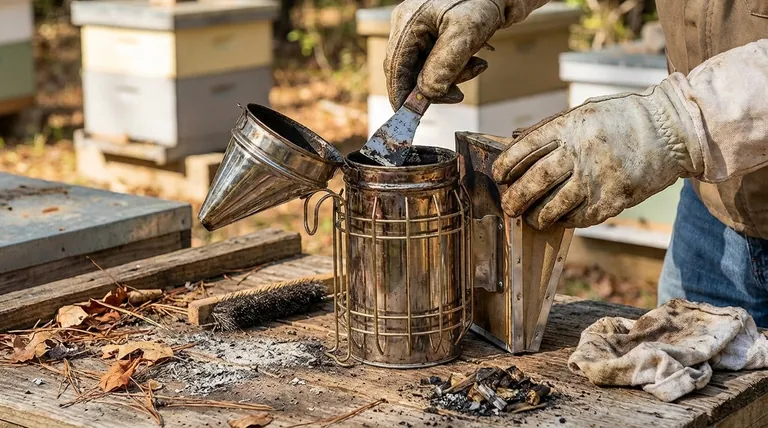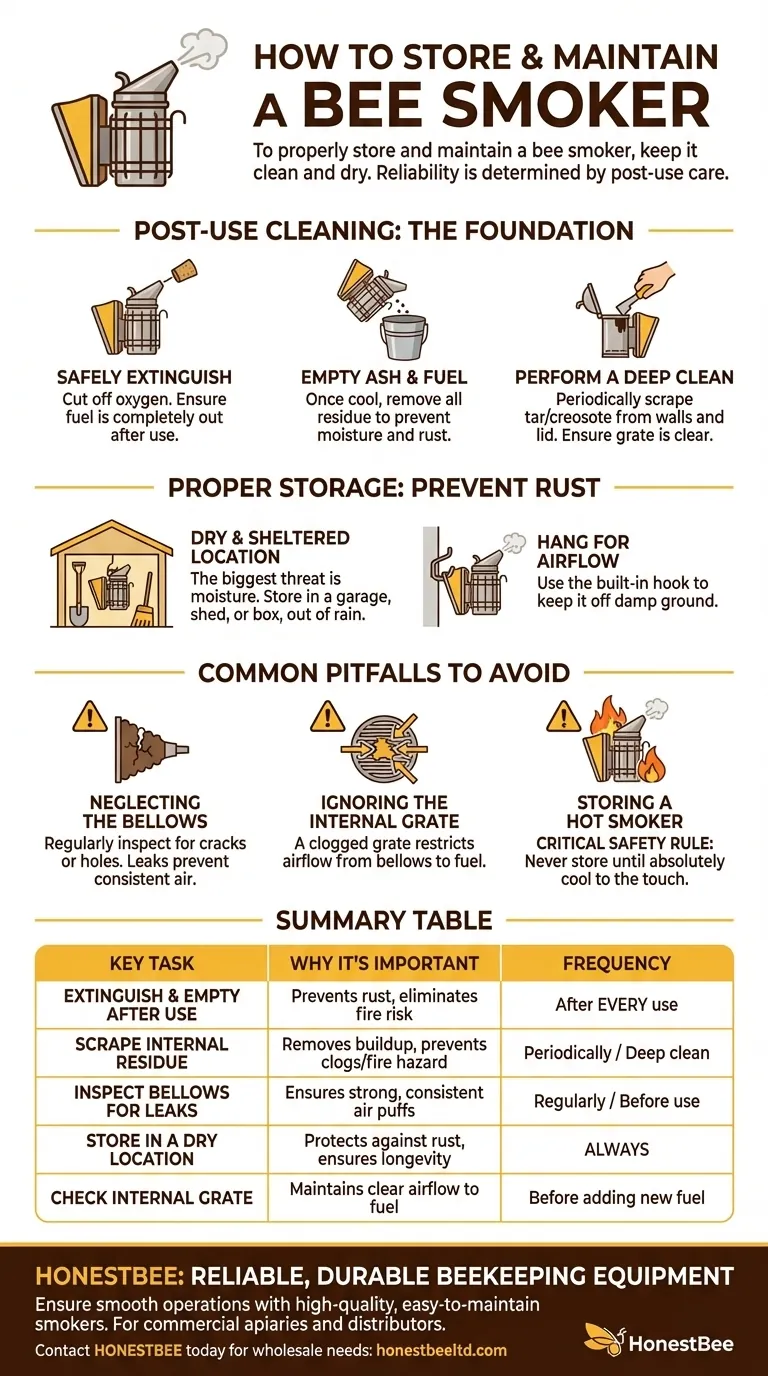To properly store and maintain a bee smoker, you must keep it clean and dry. After each use, ensure the fuel is completely extinguished and the chamber is empty, then store it in a dry location like a shed or garage to prevent rust. Regular maintenance involves scraping out residue buildup and checking the bellows for cracks or holes.
The core principle is simple: a smoker's reliability during a hive inspection is directly determined by the care you give it after the previous one. Proper maintenance isn't just about longevity; it's about ensuring safety and effectiveness when you need it most.

The Foundation of Maintenance: Post-Use Cleaning
A smoker's primary function is to smolder fuel and produce cool, white smoke. The residue from this process is the main threat to its performance and lifespan.
Why Cleaning is Non-Negotiable
Residue, a combination of creosote and tar, builds up inside the smoke chamber. If left unchecked, this buildup will clog the nozzle and internal grate, restricting airflow and making it difficult to keep the smoker lit.
Over time, this thick residue can also become a fire hazard if it's not removed.
The Post-Inspection Ritual
After you finish a hive inspection, your first step is to safely extinguish the smoker. You can do this by plugging the nozzle with grass or a cork to cut off oxygen.
Once it has completely cooled, empty all remaining ash and unburnt fuel. This simple step prevents moisture from accumulating in the ash, which accelerates rust.
Performing a Deep Clean
Periodically, you will need to perform a more thorough cleaning. Use a hive tool to scrape the thick, tar-like residue from the inside walls of the chamber and the underside of the lid.
Pay special attention to the perforated grate or stand at the bottom, as clear holes are essential for proper airflow.
Proper Storage for Maximum Longevity
Where and how you store your smoker has a direct impact on how long it will last.
The Primary Enemy: Moisture
The biggest threat to a bee smoker is rust. Storing your smoker in a dry, sheltered location is the single most important thing you can do to protect it.
While models made of stainless steel offer better resistance, all smokers have parts that can corrode over time if exposed to moisture.
Finding the Right Spot
A garage, a tool shed, or a dedicated beekeeping supply box are all excellent places for storage. The key is to keep it out of the rain and away from damp ground.
Many smokers come with a built-in hook, which is useful not only for hanging on the hive during an inspection but also for storing it off the floor.
Common Maintenance Pitfalls to Avoid
Even with the best intentions, small oversights can lead to a malfunctioning or unsafe tool. Avoiding these common mistakes is critical.
Neglecting the Bellows
The bellows are the lungs of your smoker. Regularly inspect the material (often leather or a synthetic equivalent) for cracks, tears, or holes.
Even a small leak will prevent you from delivering a strong, consistent puff of air, making it impossible to keep the fuel smoldering effectively.
Ignoring the Internal Grate
The grate at the bottom of the smoke chamber keeps the fuel elevated, allowing air from the bellows to flow underneath and feed the fire.
If this grate becomes clogged with residue or ash, airflow will be choked off. Ensure it is clear before adding new fuel.
Storing a Hot Smoker
This may seem obvious, but it is a critical safety rule. Never store a smoker until you are absolutely certain the fire is extinguished and the unit is cool to the touch. Storing a smoldering smoker is a serious fire risk.
How to Apply This to Your Routine
Your maintenance schedule should align with how you work.
- If your primary focus is hobby beekeeping: Make it a habit to empty the smoker after every use and store it somewhere dry. A deep clean once or twice a season is likely sufficient.
- If you manage numerous hives professionally: Clean your smoker after each day in the apiary. Perform weekly checks on the bellows and grate, as equipment failure costs you valuable time.
- If you are purchasing a new smoker: Invest in a stainless steel model with a protective heat cage and a removable bottom or grate, as these features significantly simplify cleaning and improve safety.
Ultimately, treating your bee smoker as the essential safety tool it is will ensure it serves you and your colonies reliably for years to come.
Summary Table:
| Key Maintenance Task | Why It's Important | Frequency |
|---|---|---|
| Extinguish & Empty After Use | Prevents rust from moisture in ash; eliminates fire risk. | After every use |
| Scrape Internal Residue | Removes creosote/tar buildup that clogs airflow and is a fire hazard. | Periodically / Deep clean |
| Inspect Bellows for Leaks | Ensures strong, consistent puffs of air to keep fuel smoldering. | Regularly / Before use |
| Store in a Dry Location | Protects against rust, the primary threat to smoker longevity. | Always |
| Check Internal Grate | Maintains clear airflow from the bellows to the fuel. | Before adding new fuel |
Ensure your beekeeping operations run smoothly with reliable, durable equipment from HONESTBEE.
For commercial apiaries and equipment distributors, equipment failure means lost time and revenue. Our wholesale-focused operations supply high-quality, easy-to-maintain bee smokers and beekeeping supplies built for professional use.
Contact HONESTBEE today to discuss your wholesale supply needs and ensure your team has the dependable tools required for success.
Visual Guide

Related Products
- Stainless Steel Honey Bee Smoker Hive and Honeycomb Smoker for Beekeeping
- Premium Traditional Copper Bee Smoker with Bellows
- European Stainless Steel Bee Smoker for Honey Bee Hive
- Economy Galvanized Beekeeping Honey Bee Smoker for Wholesale
- Heavy Duty Manual Bee Smoker Blower for Beekeeping
People Also Ask
- What is the primary purpose of using smoke in beekeeping? Calm Bees for Safer Hive Management
- What is the purpose of a bee smoker and how should it be used? A Guide to Calm, Safe Hive Inspections
- What happens to bees when they sense smoke? Unlock the Secret to Calm Hive Inspections
- How long does it take to clean a bee smoker? From 15-Minute Quick Fix to 10-Hour Deep Clean
- How did early beekeepers use bee smokers? Master Ancient Bee Calming Techniques



















